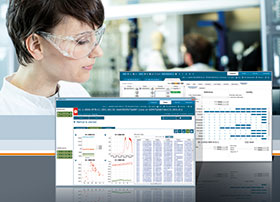

Siemens has innovated its data management software for process analytical technology (PAT) with Simatic Sipat version 5.0, which allows users to monitor and control the quality of their products in real-time during manufacturing. The latest version features a new configuration concept which increases user friendliness and shortens implementation time. Moreover, the new Dynamic Data Alignment (DDA) optimises data management for continuous manufacturing. The main applications of Simatic Sipat 5.0 are in the pharmaceutical, food and beverage and fine chemicals industries.
The new configuration concept offers an immediate graphical insight into the functionality of a Simatic Sipat method. On the instrument level, preconfigured PAT IDs can be applied. These can simply be selected during method creation, allowing fast and easy method setup. Configuring new methods is straightforward and can be done in just a few minutes. All linking processes (e.g. between collected data and calculations) can easily be performed using what are known as “wizards”. These new features allow the end users to work more quickly, reduce the training input required and speed up implementation within the organisation.
For continuous manufacturing processes, the ability to combine the right pieces of information when making quality decisions is vital. This means that data collected from different locations along the production line at different time intervals must be combined with each other to arrive at the correct product quality. Simatic Sipat 5.0 enables this by using the Dynamic Data Alignment (DDA) concept. This allows users to make fast, data-driven decisions ensuring quality, right-first-time products. Moreover, it optimises process control of the production line in real-time during manufacturing.
Furthermore, Simatic Sipat 5.0 has integrated data security functionality for secure communication between the different components and protection of customer data integrity.
About Sipat
Simatic Sipat is a scalable and modular software solution that enables companies to extend their quality assurance activities on a step-by-step basis within the scope of the PAT initiative. With PAT, product development and production processes can be monitored, controlled and optimised by measuring the critical-to-quality attributes (CQA) of raw materials, process materials and procedures. This continuous monitoring of product quality can prevent deviations from specifications and therefore reduce production costs. In addition, it allows for Real Time Release Testing, so quality inspections on final products can be reduced or completely eliminated.
For more information contact Jennifer Naidoo, Siemens Southern Africa, +27 (0)11 652 2795, [email protected], www.siemens.co.za
| Tel: | +27 11 652 2000 |
| Email: | [email protected] |
| www: | www.siemens.co.za |
| Articles: | More information and articles about Siemens South Africa |

© Technews Publishing (Pty) Ltd | All Rights Reserved